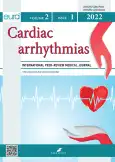Факторы сердечно-сосудистого риска у работников локомотивных бригад железнодорожного транспорта с желудочковыми нарушениями ритма
- Авторы: Метсо К.В.1, Никифоров В.С.2
-
Учреждения:
- Отделенческая больница на ст. Волховстрой ОАО РЖД
- Северо-Западный государственный медицинский университет им. И.И. Мечникова
- Выпуск: Том 2, № 1 (2022)
- Страницы: 23-29
- Раздел: Оригинальные исследования
- URL: https://journals.rcsi.science/cardar/article/view/96766
- DOI: https://doi.org/10.17816/cardar96766
- ID: 96766
Цитировать
Аннотация
Цель: оценить факторы сердечно-сосудистого риска у машинистов и помощников машинистов локомотивных бригад железнодорожного транспорта с желудочковыми нарушениями ритма.
Материалы и методы. В исследование включено 120 пациентов в возрасте от 39 до 61 года (средний возраст М ± SD: 50,4 ± 4 года), которые были разделены на две группы с желудочковыми нарушениями ритма и без желудочковых нарушений ритма. Всем исследуемым было выполнено 12-канальное суточное мониторирование ЭКГ с оценкой неинвазивных маркеров электрической нестабильности миокарда (циркадный профиль, интервал QT, поздние потенциалы желудочков, альтернация волны Т, вариабельность ритма). Оценивались традиционные факторы сердечно-сосудистого риска, а также стаж работы в профессии и уровень личностной и ситуационной тревожности по шкале Спилбергера–Ханина.
Результаты. В первой группе, по сравнению со второй, выявлены значимые различия по длительности интервала PQ (в дневное и ночное время) и по показателям поздних потенциалов желудочков (RMS 40 и TotQRSF). При анализе факторов риска в двух группах встречались повышенные значения уровня общего холестерина крови, риск по шкале SCORE находился на уровне умеренного. В группе работников с желудочковыми нарушениями ритма установлены более высокие показатели общего холестерина крови, частоты курения и употребления алкоголя. У лиц с желудочковыми нарушениями ритма выявлена значимая связь между количеством зарегистрированных одиночных мономорфных желудочковых экстрсистол с возрастом работника (r = –0,3, р < 0,05), и уровнем артериального давления (АД) (r = 0,3, р < 0,05), установлена связь уровня тревоги и регистрации одиночных суправентрикулярных экстрасистол (r = –0,3, р < 0,05). Во второй группе выявлена значимая корреляционная связь между количеством зарегистрированных одиночных суправентрикулярных экстрасистол с возрастом (r = 0,2, р < 0,05) и стажем труда в профессии машиниста (r = 0,2, р < 0,05), уровнем АД (r = 0,2, р < 0,05), и уровнем тревоги по шкале Спилбергера–Ханина (r = 0,3, р < 0,05).
Выводы. Машинисты локомотивных бригад железнодорожного транспорта с желудочковыми нарушениями ритма характеризуются более высоким уровнем общего холестерина крови и более высокой частотой курения и употребления алкоголя. У них отмечаются значимые изменения длительности интервала PQ (в дневное и ночное время) и показателей поздних потенциалов желудочков (RMS 40 и TotQRSF) по данным холтеровского мониторирования. У машинистов локомотивных бригад железнодорожного транспорта имеется связь количества желудочковых нарушений ритма с возрастом и офисными значениями систолического и диастолического АД.
Полный текст
Открыть статью на сайте журналаОб авторах
Кристина Владимировна Метсо
Отделенческая больница на ст. Волховстрой ОАО РЖД
Email: metso.kr@gmail.com
ORCID iD: 0000-0002-3299-9248
SPIN-код: 3140-3240
врач
Россия, ВолховВиктор Сергеевич Никифоров
Северо-Западный государственный медицинский университет им. И.И. Мечникова
Автор, ответственный за переписку.
Email: viktor.nikiforov@szgmu.ru
ORCID iD: 0000-0001-7862-0937
SPIN-код: 4652-0981
Scopus Author ID: 5669956640
ResearcherId: O-7760-2014
профессор
Россия, Санкт-ПетербургСписок литературы
- Шляхто Е.В., Арутюнов Г.П., Беленков Ю.Н., и др. Национальные рекомендации по определению риска и профилактике внезапной сердечной смерти. 2-е издание. Москва: Медпрактика-М, 2018. 247 с.
- Priori S.G., Blomström-Lundqvist C., ESC Scientific Document Group, et al. 2015 ESC Guidelines for the management of patients with ventricular arrhythmias and the prevention of sudden cardiac death: The Task Force for the Management of Patients with Ventricular Arrhythmias and the Prevention of Sudden Cardiac Death of the European Society of Cardiology (ESC). Endorsed by: Association for European Paediatric and Congenital Cardiology (AEPC) // Eur Heart J. 2015. Vol. 36, No. 41. P. 2793–2867. doi: 10.1093/eurheartj/ehv316
- Sutton N.R., Banerjee S., Cooper M.M., et al. Coronary Artery Disease Evaluation and Management Considerations for High Risk Occupations: Commercial Vehicle Drivers and Pilots // Circ Cardiovasc Interv. 2021. Vol. 14, No. 6. ID e009950. doi: 10.1161/CIRCINTERVENTIONS.120.009950
- Saraei M., Najafi A., Heidarbagi E. Risk factors for obstructive sleep apnea among train drivers // Work. 2020. Vol. 65, No. 1. P. 121–125. doi: 10.3233/WOR-193064
- Iridiastadi H. Fatigue in the Indonesian rail industry: A study examining passenger train drivers // Appl Ergon. 2021. Vol. 92. ID 103332. doi: 10.1016/j.apergo.2020.103332
- Жидкова Е.А., Найговзина Н.Б., Калинин М.Р., и др. Результаты анализа причин внезапной смерти среди работников локомотивных бригад // Кардиология. 2019. № 6. С. 42–47. doi: 10.18087/cardio.2019.6.2552
- Zdrenghea D., Poantă L., Gaita D. Cardiovascular risk factors and risk behaviors in railway workers. Professional stress and cardiovascular risk // Rom J Intern Med. 2005. Vol. 43, No. 1-2. P. 49–59.
- Piros S., Karlehagen S., Lappas G., Wilhelmsen L. Risk factors for myocardial infarction among Swedish railway engine drivers during 10 years follow-up // J Cardiovasc Risk. 2000. Vol. 7, No. 5. P. 395–400. doi: 10.1177/204748730000700513
- Макаров Л.М., Комолятова В.Н., Куприянова О.О., и др. Национальные российские рекомендации по применению методики холтеровского мониторирования в клинической практике // Российский кардиологический журнал. 2014. № 2. С. 6–71. doi: 10.15829/1560-4071-2014-2-6-71
- Василенко В.С., Бондарев С.А. Заболеваемость сердечно-сосудистой системы у лиц, испытывающих хроническое профессиональное перенапряжение // Ученые записки СПбГМУ им. акад. И.П. Павлова. 2012. Т. 19, № 1. С. 54–58.
- Никифоров В.С., Метсо К.В. Электрокардиографические предикторы внезапной сердечной смерти // Consilium Medicum. 2018. Т. 20, № 5. С. 29–33. doi: 10.26442/2075-1753_2018.5.29-33
- Латфуллин И.А., Ким З.Ф, Тептин Г.М. Поздние потенциалы желудочков // Вестник Аритмологии. 2008. № 53. С. 44–55.
- Макаров Л.М. Внезапная смерть у молодых спортсменов // Кардиология. 2010. Т. 50, № 2. C. 78–83.
- Жидкова Е.А., Гутор Е.М., Калинин М.Р., и др. Анализ факторов, ассоциированных с заболеваемостью работников локомотивных бригад // Кардиоваскулярная терапия и профилактика. 2019. Т. 18, № 1. С. 102–106. doi: 10.15829/1728-8800-2019-1-102-106
Дополнительные файлы







